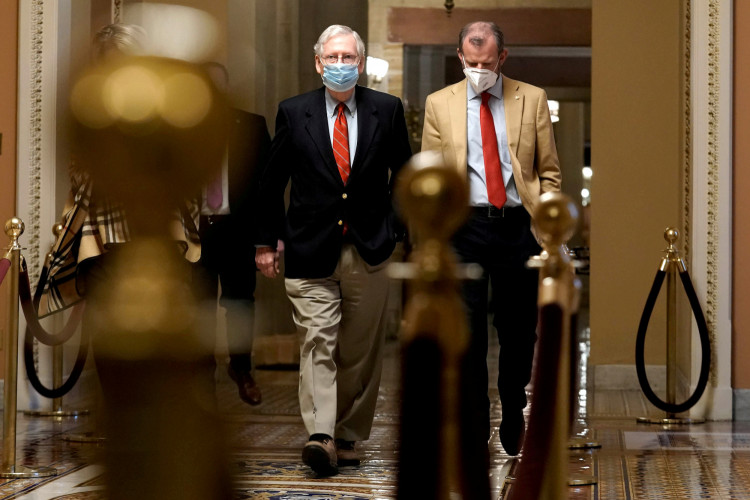The $900 billion pandemic aid package expected to win Congressional approval on Monday will deliver support to a recession-ravaged economy slowing under a deadly coronavirus surge, and set it up for a stronger recovery next year as vaccines become more widely available, economists said.
But it comes months after the last big fiscal aid package was passed and lacks direct help to struggling states and cities, as millions remain unemployed and businesses suffer anew from fresh restrictions to slow spread of the virus.
"While the deal is months late and will likely fall short of what is needed to prevent a rough winter, it's better than nothing," said Gregory Daco, the chief U.S. economist for Oxford Economics.
Even before it is signed, there is fierce debate over whether more aid will be needed, and if it will reach the neediest Americans.
Still, San Francisco Federal Reserve President Mary Daly called the aid "unequivocally beneficial" in an interview on Sunday on CBS' "Face the Nation."
BRIDGE TO BETTER TIMES
The U.S. economy is roughly $1 trillion smaller than what it would have been without the pandemic and resulting recession.
That estimate is based on the gap between where economic output was headed this year before onset of the health crisis - it started 2020 at about $21.7 trillion - and where it is now.
The new bill, at roughly the size of that gap, contains $166 billion for checks to most Americans, $120 billion in extra payments to the unemployed, and nearly $300 billion in new "payroll protection" loans for companies that keep employees on the books, among other things.
To Carl Tannenbaum, chief economist at Northern Trust in Chicago, the package's correlation with U.S. economic gap is one indication "they've sized (it) almost properly."
The economy is expected to rebound strongly next year once vaccines make it safer to be out and about, he said, so there's less of a need for the $2 trillion or more that some economists, like those at the Economic Policy Institute https://www.epi.org/publication/principles-for-the-relief-and-recovery-phase-of-rebuilding-the-u-s-economy-use-debt-go-big-and-stay-big-and-be-very-slow-when-turning-off-fiscal-support, have called for.
Kathryn Anne Edwards, an economist at Rand who focuses on the labor market, said the lessons of recent history suggest that spending too little would be a mistake.
"In past recessions, we erred on the side of being fiscally conservative... and it was not enough and people were unemployed for a staggering amount of time," Edwards said.
TARGETED HELP FOR JOBLESS
Of 22 million jobs shed since the start of the pandemic, about 12 million have come back, leaving a shortfall of nearly 10 million, Labor Department data shows.
The package will add $300 per week to regular unemployment benefits through mid-March, and extend benefits to gig workers who otherwise would not qualify, that were set to expire this week. It also extends an eviction moratorium through January.
Taking care of the unemployed, whose benefits were going to expire is "the most urgent thing that needs to be done right now," said Wendy Edelberg, director of the Hamilton Project and senior fellow at the Brookings Institution. Still, she worries more help will be needed soon.
"My main concern is that the support - for unemployment insurance but also the eviction moratorium - doesn't last nearly long enough, she said. "The economic weakness could come pretty fast in the first quarter."
Targeting funds to people who have lost their jobs is an extremely effective use of government aid, economists say, because it helps the neediest and because it is likely to be spent quickly and fully, delivering a boost to the economy.
At the end of November, 20.6 million Americans were receiving some form of unemployment benefit, Labor Department figures show.
BROADER SUPPORT WITH $600 CHECKS
Official unemployment numbers do not adequately reflect the total need in the United States, economists say.
"How many people are hungry right now, how many people are behind on rent, how many children are behind in school - these measures of hardship are not collected the way unemployment rates are," says Rand's Edwards.
The stimulus attempts to address that in part by giving Americans who made $75,000 or less last year one-time checks of $600, providing an immediate boost.
Other Americans may not need to use the money right away, said Arindrajit Dube, an economics professor at the University of Massachusetts, Amherst. U.S. households have built up more than $1 trillion in savings during the pandemic, data from the Federal Reserve shows.
That, along with any money saved from stimulus checks, is ammunition that will deliver "super-charged stimulus," Dube predicted, once vaccinations become more widespread and people spend extra cash on summer travel or vacation rentals. "That will potentially speed our recovery much more than anything else."
SMALL BUSINESSES
Economists overall are less enthusiastic about the $284 billion in paycheck protection loans, the biggest chunk of the package's $325 billion in aid to small businesses. Research on the $525 billion distributed under the program first created in March shows it "is pretty inefficient both as relief and as recovery," said Josh Bivens, director of research at the Economic Policy Institute.
A study https://opportunityinsights.org/wp-content/uploads/2020/05/tracker_paper.pdf by non-partisan Opportunity Insights suggested the cost per job saved by the PPP was $377,000.
That said, the program - which funneled money to more than five million enterprises - should help bolster borrowers' balance sheets, setting up for a faster recovery, Dube said.
The package includes no direct support for financially stressed state and local governments, which have reduced payrolls by slashing about 1.3 million jobs since February.
It does devote more than $250 billion to schools, transit, vaccine distribution and testing, food aid, childcare and rental assistance.
"Those kinds of fiscal support take some burden off of state and local governments," Edelberg said.






